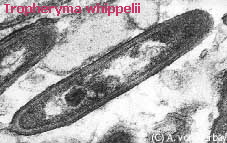Since the bacterial nature of Whipple┤s disease was recognized in 1961, several attempts were performed to culture the associated bacterium. Some
of them were initially assumed to have been successful, but their results could never be reproduced by others. ( 3, 4, 5, 6 ) In 2000, a first case of successful cultivation associated with human fibroblast cell
lines was reported, which eventually could be reconfirmed. ( 7, 8; 6 ) In 2003, the new knowledge of the genome provided information for a first in vitro cultivation without host cells ( 9 ). (see:
Bacterium/Growth ) References
- Dobbins WO III, Kawanashi H (1981). Bacillary characteristics in Whipple┤s disease: an electron microscopic study. Gastroenterology 80 1468-1465
- Silva MT, Macedo PM, Moura-Mounes JF (1985). Ultrastructure of bacilli and the bacillary origin of the macrophagic inclusions in Whipple┤s disease. J Gen Microbiol 131: 1001-1013
- Clancy RL, Tomkins WAF, Muckle TJ, Richardson H, Rawls WE (1975). Isolation and characterization of an aetiological agent in Whipple┤s disease. Br Med J 3:568-570
- Schoedon G, Goldenberger D, Forrer R, Gunz A, Dutly F, H÷chli M, Altwegg M, Schaffner A (1997) Deactivation of macrophages with interleukin-4 is the key to the isolation of Tropheryma whippelii
. J Infect Dis 176: 672-677
- Zaaijer H, Savelkoul P, Vandenbroucke-Grauls C (1999). Tropheryma whippelii is easily ingested by interleukin-4-deactivated macrophages, but does not multiply. Ned Tijdschr Geneesk 143: 388-392
- Maiwald M, von Herbay A, Fredericks DN, Ouverney CC, Kosek JC, Relman DA (2003). Cultivation of Tropheryma whipplei from cerebrospinal fluid. J Infect Dis 188: 801-808
- Raoult D, Birg ML, La Scola B, Fournier PE, Enea M, Lepidi H, Roux V, Piette JC, Vandenesch F, Vital-Durand D, Marrie TJ (2000). Cultivation of the bacillus of Whipple┤s disease. N Engl J Med 342: 620-625
- Raoult D, La Scola B, Lecocque P, Lepidi H, Fournier PE (2001). Culture and immunological detection of Tropheryma whippelii from the duodenum of a patient With Whipple Disease. JAMA 285: 1039-1043
- Renesto P, Crapoulet, Ogata H, La Scola B, Vestris G, Claverie JM, Raoult D (2003). Genome-based design of a cell-free culture medium for Tropheryma whipplei. Lancet 362; 447-449
|
